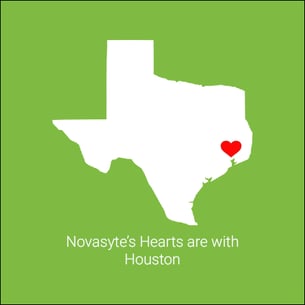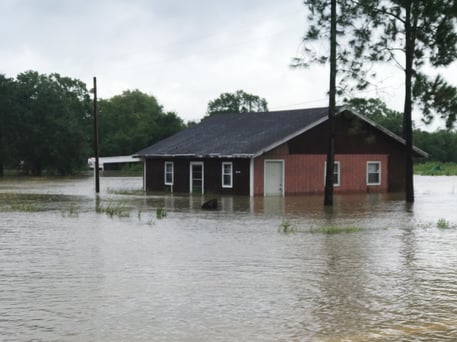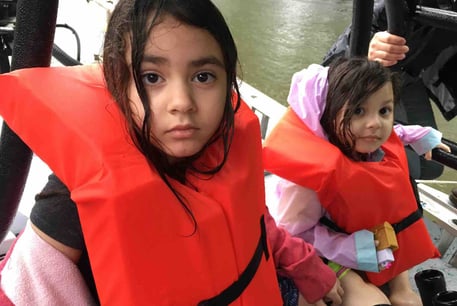 We continue to think about the Greater Houston Area, the Caribbean and Florida during this difficult time. At Novasyte, we are proud to say that one of our team members, Marissa Murphy, was on site with her search and rescue team supporting the much needed relief efforts in the most crucial 72 hours following the storm. We sat down with Marissa and interviewed her on her experience visiting the Greater Houston Area last week.
We continue to think about the Greater Houston Area, the Caribbean and Florida during this difficult time. At Novasyte, we are proud to say that one of our team members, Marissa Murphy, was on site with her search and rescue team supporting the much needed relief efforts in the most crucial 72 hours following the storm. We sat down with Marissa and interviewed her on her experience visiting the Greater Houston Area last week.
1. What organization do you belong to?
"The organization I belong to is called H.E.A.R.T, which stands for Humanitarian Emergency Aid Response Team. H.E.A.R.T was established in 2005 after our search, rescue and disaster relief services were first utilized during Hurricane Katrina."
2. What did you and your team do to prepare for the Hurricane Harvey relief efforts?

3. How did you communicate with people affected by the hurricane before you got to Texas?

4. What did you learn from this experience?
"The experience with every disaster is always different. I learned how unpredictable natural disasters can be and how crucial it is to have an evacuation plan and proper supplies. You never know the severity of an natural disaster's impact until you are experiencing it first-hand."
5. Is there anything that the general public can do to help support the relief efforts in Texas, the Caribbean and Florida?
"The best way for people to help would be to raise or donate money to the current hurricane relief efforts so we can help even more families who lost many, if not all of their possessions. This will help the rebuilding process. The best thing to do remotely is to help give hurricane preparation tips and advice via social media to help communities get even more prepared."
Interested in supporting a cause? Hurricane organizations you can donate to:
Overall hurricane relief organizations:
- Direct Relief
- Unicef USA
- Save the Children
- Team Rubicon
- H.E.A.R.T (Marissa's Organization)
Hurricane Harvey relief organizations:
- Houston Humane Society
- Houston Food Bank
- South Texas Blood & Tissue Center
- H.E.A.R.T (Marissa's Organization)
Hurricane essentials:
- Traditional, Wall Phone
- First-Aid Kit
- Water Supply
- Make sure you have plenty of water. Plan on having water to support you for a minimum of one week beyond the time you anticipate being in shelter. Depending on the remoteness of your location, you may need to plan for more.
- Food Supply
- Canned foods such as tuna, salmon, chili, vegetables, or fruits
- Peanut butter or almond butter
- Cereal
- Dried fruit
- Nuts
- Battery-Powered or Hand-Crank Radio
- Blow-up Mattress
- You can use this to place on top of you during the hurricane if there is the potential for furniture to fall or walls/ceilings to collapse.
- Whistle to Signal for Help
- Extension Cord
- Plug it into the highest outlet in the area of your home nearest to your attic so you can keep your phone charged. This will support communications with emergency responders while the towers are still up, all while minimizing your risk of electrocution.
- Canoe
- Make sure you are in a safe location - Buildings with a wooden foundation are not safe. Be sure to position you and your family in a building without windows and with a concrete foundation. A bathroom, closet or small storage room are the safest places to be during a hurricane. Be sure to stay close to the corners of the room for added structural support, if there is a risk of the walls or ceilings collapsing.
- Don't exit the room too early - If the hurricane is going over your home when you get into the middle of the eye, it will be silent. Do not let this fool you. The hurricane has not passed yet until the second wall goes past. Thus, do not leave your safe position until the front and back wall of the hurricane has past. You can expect the second wall to be worse than the first wall. This noise and shaking will indicate when the second wall has started.
- Protect your house - If you need to shelter in a location different than your home, you should try to board up your windows with plywood prior to leaving. This should significantly reduce the damage to your home.
- Be cautious off standing water for up to two weeks following the hurricane - Fallen power lines could increase the danger of electrocution to you and your family.
Hurricane Irma and Jose preparedness
For those attempting to find evacuation centers in Florida, please review this document below and contact them for assistance.

To learn more about Novasyte, visit us here.





